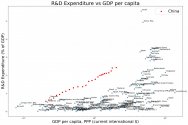A thread on the reforms of the 3rd Plenum of the CCP
Another analysis on the Third Plenum
Several Takes on the Third Plenum Decision
Analysis on the middle class's spending and consumption being insufficient to generate economic rebalancing and maintain stable and healthy growth of China's economy, thus generating a statement and conclusion that consumption growth within the lower income class is higher than that of the middle class.
Markets with Bureaucratic Characteristics: How Economic Bureaucrats Make Policies and Remake the Chinese State (book excerpt) Yingyao Wang opens the black box of the Chinese bureaucracy to reveal the agency of the men and women who designed and redesigned Chinese economic policy.
China property winding-up sagas show difficulty of recovering assets Country Garden gets six-month respect as other cases highlight 'enforceability' problem month-amid-tepid-demand China's factory activity shrinks for third month amid tepid demand Stimulus measures have so far failed to revive business confidence
China's Politburo calls for consumption boost to drive 2024 growth Top leadership acknowledges 'many' risks, calls for acceleration of fiscal policies
Another analysis on the Third Plenum
Several Takes on the Third Plenum Decision
Analysis on the middle class's spending and consumption being insufficient to generate economic rebalancing and maintain stable and healthy growth of China's economy, thus generating a statement and conclusion that consumption growth within the lower income class is higher than that of the middle class.
Markets with Bureaucratic Characteristics: How Economic Bureaucrats Make Policies and Remake the Chinese State (book excerpt) Yingyao Wang opens the black box of the Chinese bureaucracy to reveal the agency of the men and women who designed and redesigned Chinese economic policy.
China property winding-up sagas show difficulty of recovering assets Country Garden gets six-month respect as other cases highlight 'enforceability' problem month-amid-tepid-demand China's factory activity shrinks for third month amid tepid demand Stimulus measures have so far failed to revive business confidence
China's Politburo calls for consumption boost to drive 2024 growth Top leadership acknowledges 'many' risks, calls for acceleration of fiscal policies

